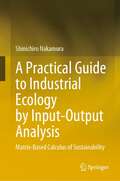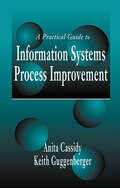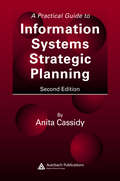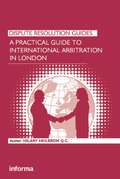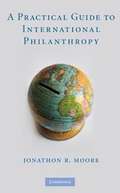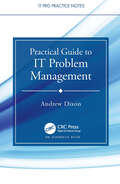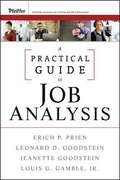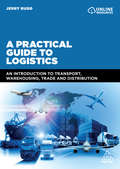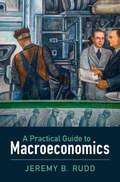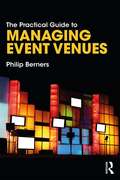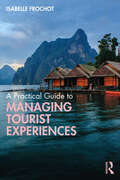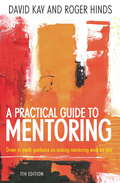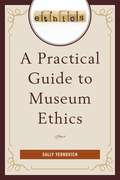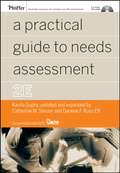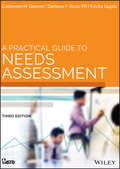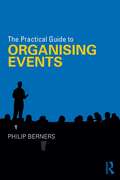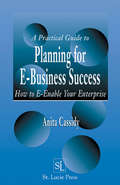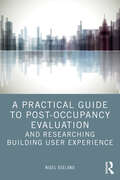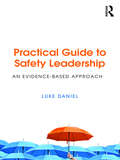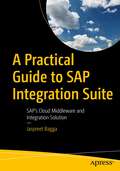- Table View
- List View
A Practical Guide to Industrial Ecology by Input-Output Analysis: Matrix-Based Calculus of Sustainability
by Shinichiro NakamuraThis book addresses the growing need for a standard textbook on input-output analysis (IO) within the context of industrial ecology (IE). IE is a discipline dedicated to providing system-wide, quantitative, and science-based solutions for sustainable development challenges, and its global importance has been rapidly increasing. The primary analytical tools of IE are life-cycle assessment (LCA) and material flow analysis (MFA). IO has been widely utilized for LCA since the late 1990s and is increasingly being applied to MFA as well. This trend is being driven by the greater availability and application of global IO data, which now includes an ever-expanding number of countries and regions. Despite the presence of excellent textbooks on IO and IE individually, there is a lack of resources that integrate these two fields. This book seeks to fill that gap by focusing on the practical application of IO to IE, specifically in the context of LCA and MFA. By combining these methodologies, readers can gain valuable insights into sustainable development issues and contribute to more effective solutions in the field of IE.
A Practical Guide to Information Systems Process Improvement
by Anita Cassidy Keith GuggenbergerWhen you invest in expensive technology and systems, you want to get the most out of them. Process improvement has been used for years as an effective strategy to reduce costs, shorten cycle times, improve quality, and increase user satisfaction in other areas of business such as Quality, Manufacturing, and Engineering. While there are many books a
A Practical Guide to Information Systems Strategic Planning
by Anita CassidyThe foundation of a successful information systems strategic plan is the recognition that business direction and requirements must drive the IS strategy and computing architecture. A Practical Guide to Information Systems Strategic Planning, Second Edition outlines a systematic approach to guide you through the development of an effective IS plan t
A Practical Guide to International Arbitration in London (Dispute Resolution Guides)
by Hilary HeilbronWith the development of international arbitration globally and London as a leading arbitration centre, the need for knowledge of the subject extends to a wider legal audience. A Practical Guide to International Arbitration in London takes a pragmatic look at how to run an international arbitration with a London seat. It explores on a stage-by-stage basis the tactical, procedural and legal issues that need to be considered in an international arbitration in London from the perspective of the arbitral process, including its relationship with the support given by the English courts. The book also examines the role of the English courts in assisting foreign arbitrations.
A Practical Guide to International Philanthropy
by Jonathon R. MooreThis book is a practical guide addressing the issues faced by philanthropists seeking to engage in international charitable activities and offers alternative approaches to traditional U. S. -based foundations. A significant portion of the regulatory burdens facing U. S. private foundations derives from tax benefits available to donors under U. S. law. A charitable organization must initially qualify and then be maintained under a complex regulatory regime. If some or all of these tax benefits are either unavailable or not needed, or if the tax advantages are outweighed by the burdens of regulatory compliance, foundations can be established in foreign jurisdictions. Charitable activities can then be operated flexibly and privately outside the constraints of the U. S. regulatory regime. For existing private foundations, this book suggests strategies designed to hedge against ever-increasing and intrusive regulation.
Practical Guide to IT Problem Management (IT Pro Practice Notes)
by Andrew DixonSome IT organisations seem to expend all their energy firefighting – dealing with incidents as they arise and fixing, or patching over, the breakage. In organisations like this, restarting computers is seen as a standard method to resolve many issues. Perhaps the best way to identify whether an organisation understands problem management is to ask what they do after they have restarted the computer. If restarting the computer fixes the issue, it is very tempting to say that the incident is over and the job is done. Problem management recognises that things do not improve if such an approach is taken. Such organisations are essentially spending their time running to stay in the same place. Written to help IT organisations move forward, Practical Guide to IT Problem Management presents a combination of methodologies including understanding timelines and failure modes, drill down, 5 whys and divide and conquer. The book also presents an exploration of complexity theory and how automation can assist in the desire to shift left both the complexity of the problem and who can resolve it. The book emphasises that establishing the root cause of a problem is not the end of the process as the resolution options need to be evaluated and then prioritised alongside other improvements. It also explores the role of problem boards and checklists as well as the relationship between problem management and Lean thinking. This practical guide provides both a framework for tackling problems and a toolbox from which to select the right methodology once the type of problem being faced has been identified. In addition to reactive methods, it presents proactive activities designed to reduce the incidence of problems or to reduce their impact and complexity should they arise. Solving problems is often a combination of common sense and methodologies which may either be learnt the hard way or may be taught. This practical guide shows how to use problem solving tools and to understand how and when to apply them while upskilling IT staff and improving IT problem solving processes.
A Practical Guide to Job Analysis
by Erich P. Prien Louis G. Gamble Jr. Leonard D. Goodstein Jeanette GoodsteinPresenting the first book that provides HR professionals with a context for understanding the importance of doing a proper job analysis together with a step-by-step guide to conducting such an analysis. This unique guide contains a series of eight ready-to-use templates that provide the basis for conducting job analyses for eight different levels of job families, from the entry-level to the senior manager/executive.
A Practical Guide to Logistics: An Introduction to Transport, Warehousing, Trade and Distribution
by Jerry RuddFew people come into logistics management with knowledge and experience of all aspects of the profession. Some may have worked their way up from driving a vehicle but know little of warehouses, others may find themselves taking responsibility for logistics as part of a wider remit such as operations. A Practical Guide to Logistics aims to equip them with the necessary knowledge to move on to the next stage, with simple non-technical explanations of the options available, and impartial advice on how to choose the right option for their business. It is also an excellent primer for students studying logistics for the first time, on BSc or MSc courses, as well as practitioners on professional training courses. A Practical Guide to Logistics is a straightforward guide taking readers through all aspects of this fascinating industry, covering packaging, transportation, warehousing and exporting and importing of goods. There is a real need for this basic knowledge, both for practitioners starting out in the industry or more experienced practitioners who may have gaps in their knowledge. The book examines each aspect of logistics in turn and the text is supported by numerous illustrations.
A Practical Guide to Logistics: An Introduction to Transport, Warehousing and Distribution
by Jerry RuddFew enter the logistics management industry with experience in all aspects of the profession. This book provides clear, workable explanations and guidance on the fundamentals to achieve success.A Practical Guide to Logistics is a straightforward guide taking readers through all aspects of the industry, covering packaging, transportation, warehousing and exporting and importing of goods. This fully updated second edition features a new chapter on Health and Safety in the field, and coverage of the most recent developments impacting logistics, including automation and electric vehicles.It equips readers with the necessary knowledge to progress in their careers and provides balanced advice on how to choose the right option for their business. A Practical Guide to Logistics is an essential introduction for practitioners, undergraduate and postgraduate students of logistics.
A Practical Guide to Macroeconomics
by Jeremy B. RuddThere is an uncomfortably large gulf between academic research and what policy economists use to understand the economy. A Practical Guide to Macroeconomics shows how economists at policy institutions approach important real-world questions and explains why existing academic work – theoretical and empirical – has little to offer them. It argues that this disconnect between theory and practice is problematic for policymaking and the economics profession and looks at what's needed to make academic research more relevant for policy. The book also covers topics related to economic measurement and provides a compact overview of US macroeconomic statistics that will help researchers use these data in a better-informed way.
The Practical Guide to Managing Event Venues
by Philip BernersThis is a short, accessible and practical guide to running venues which are in the business of hosting events. Using honest guidance peppered with the author’s real-life situational anecdotes to contextualise the topics, the book is logically structured around the key stages of event management: pre-event, onsite and post-event. Topics covered include developing the client relationship, marketing, financial accountability, risk, interdepartmental communication, onsite procedures and post-event evaluation. This is a fundamental resource for all event management and hospitality students. It is also a book for anybody who manages a venue or is a venue event manager. The Practical Guide to Managing Event Venues makes the business of venue management appealing, understandable and achievable.
A Practical Guide to Managing Tourist Experiences
by Isabelle FrochotThis book provides students with a concise and practical guide that presents key understandings of the tourist experience and provides strategic guidance on how to develop an impactful and memorable experience. Chapters follow the path of the tourist journey, firstly exploring consumer behaviour, the decision-making process and the tourist’s need for escape, and providing insights into the strategic implications of consumer behaviour and the concept of immersion in tourism. Subsequent chapters look at the impact of experiences; consider trends in tourism experience such as wellness, sustainability, authenticity and fantasy; and provide experience design models. The final chapter offers a unique ten-step approach to designing impactful and memorable tourist experiences. Highly practical and engaging, this book is packed full of case studies and examples, from forest bathing in Finland to truffle hunting in Italy, as well as tools and exercises to guide the design process. This book offers students a full understanding of how the experience is lived from the tourist perspective, how tourism providers can manage that process and how to develop successful experimental marketing interventions. This is essential reading for all tourism students and future tourism managers.
A Practical Guide To Mentoring 5e: Down To Earth Guidance On Making Mentoring Work For You
by David Kay Roger HindsMentoring is a rewarding experience. You will play an active and invaluable part in the development of another person and further your own career at the same time. This concise book will take you step-by-step through the process and show you: - How to become an effective mentor - What qualities, methods and processes are required - How to prepare yourself and the mentee - How to avoid the common pitfalls. Whichever sector you work in, this extremely practical book will clarify the whole mentoring process from start to finish, and support you every step of the way.
A Practical Guide To Mentoring 5e: Down to earth guidance on making mentoring work for you
by David Kay Roger HindsMentoring is a rewarding experience. You will play an active and invaluable part in the development of another person and further your own career at the same time. This concise book will take you step-by-step through the process and show you: how to become an effective mentor; what qualities, methods and processes are required; how to prepare yourself and the mentee; how to avoid the common pitfalls. Whichever sector you work in, this extremely practical book will clarify the whole mentoring process from start to finish, and support you every step of the way.
A Practical Guide To Museum Ethics
by Sally YerkovichAre your collections up for grabs? Does the spouse of one of your trustees have too much to say about developing the exhibition schedule? How much is too much public participation? Where does a curator's authority begin and end? With money increasingly difficult to raise, is a museum more likely to accede to potential funders' demands even when those demands might compromise the museum's integrity? When a museum is struggling with debilitating debt, should the sale of selected items from its collections and the use of the resulting proceeds bring the museum into a more stable financial position? When a museum attempts to build its attendance and attract local visitors by crowdsourcing exhibitions, is it undermining its integrity? Ethical questions about museum activities are legion, yet they are usually only discussed when they become headlines in newspapers. Museum staff respond to such problems under pressure, often unable to take the time required to think through the sensitive and complex issues involved. Grounded in a series of case studies, A Practical Guide to Museum Ethics confronts types of ethical dilemmas museums face and explores attempts to resolve them in chapters dealing with -accessibility, disability, and diversity; -collections; -conflict of interest; -governance; -management; -deaccessioning; and -accountability and transparency. Suitable for classroom use as well as a professional reference, here is a comprehensive, practical guide for dealing with ethical issues in museums.
A Practical Guide to Needs Assessment
by Catherine M. Sleezer Darlene F. Russ-Eft Kavita GuptaThis thoroughly revised edition of the best-selling resource A Practical Guide to Needs Assessment offers a practical and comprehensive guide for practitioners who are responsible forIntroducing a training programCreating adult education programsAssessing the development needs of a workforceImproving individual, group, organization or interorganizational performance in the workplaceImplementing community, national, or international development interventionsDesigned as a resource for practitioners, this book is filled with how-to information, tips, and case studies. It shows how to use data-based needs assessments to frame people-related problems and performance, improvement opportunities to obtain support from those who are affected by the changes, make effective decision, and increase efficiency.
A Practical Guide to Needs Assessment: Includes First Things Fast And A Practical Guide To Needs Assessment (Business And Management Ser.)
by Catherine M. Sleezer Darlene F. Russ-Eft Kavita GuptaA Practical Guide to Needs Assessment, Third Edition For fifteen years, A Practical Guide to Needs Assessment has been the go-to text for those who are seeking useful, systematic approaches to needs assessment. Needs assessment is the first step in training, performance improvement, and community development projects. This thoroughly revised and updated edition contains a treasury of resources including a toolkit of ready-to-use templates and job aids that you can customize for your own use. Illustrative case studies and tips show how to assess needs for individuals, teams, organizations, government agencies, and communities. This book combines a how-to text and reference tool for trainers, performance improvement professionals, and students. Managers and community leaders use it to get to the root of their learning and performance problems, make effective decisions, and obtain support for their most pressing issues. Updates to the third edition include: Links to online resources, including a needs assessment book that you can download for free, ethical guidelines, and vendors who assess individual, group and organizational needs. A new chapter on the complex needs assessment approach with new toolkit forms. A summary of the recent advances in our knowledge about learning, training, and performance that you can use to quickly prepare for client meetings. Guidelines on workforce surveys, such as employee engagement surveys. An Instructor’s Guide that contains discussion questions, assessments materials, and new exercises for each chapter. You can use this book to quickly access up-to-date information on the fundamentals of needs assessment including current models, theories, and resources. You can also learn how to manage and report a needs assessment project and access professional ethical guidelines. Learn five approaches to needs assessment: knowledge and skills analysis, job and task analysis, competency-based needs assessment, strategic needs assessment, and complex needs assessment.
The Practical Guide to Organising Events (The Practical Guide to Events and Hotel Management Series)
by Philip BernersThe Practical Guide to Organising Events is a short, accessible and practical guide on how to successfully plan and organise a variety of event types in a wide range of contexts. The core sections of the text are logically structured around the key stages of event management – pre-event, on-site and post-event – offering essential practical insight and guidance throughout the whole process. Topics covered include proposal writing, budget, funding and sponsorship, health and safety, security and evaluation. This is a fundamental resource for all events management students running and organising an event as part of their degree programme. It is also a book for anybody who just happens to be tasked with organising an event such as an office party, a social networking event, Christmas party or family wedding. Based on experience, using real-life case studies and anecdotal examples, The Practical Guide to Organising Events ultimately makes the business of events management appealing, understandable and achievable.
A Practical Guide to Paying off Your Mortgage Early
by Lien Luu Sukanlaya SawangOwning a property is a dream for many people, and borrowing from banks is often essential to achieve this. However, having a mortgage can cause real anxiety because of the latent fear of losing our home if we cannot keep up with mortgage payments. Traditionally, homeowners repay their debt over 25 years, but high house prices have made it necessary to increase the term up to 40 years to make monthly payments affordable. Spreading the debt over a longer period of time not only means that borrowers have to pay more interest, but they are also exposed to other risks such as potential interest rate rises and changes in personal circumstances affecting their mortgage eligibility. These can lead to financial worries, financial stress, and reduced well-being. There are few practical guides available to show borrowers how to manage their mortgage debt more effectively, and how to repay their mortgage quickly so that they are debt-free.This book seeks to empower consumers, young and old, by providing a roadmap to help borrowers achieve financial security through planning for the future, insuring their income, and setting up an emergency fund. It also outlines simple strategies for an early repayment of debt, including paying off the capital, making extra payments, and monitoring their mortgage debt. In doing so, it aims to help readers improve their general well-being, enhance their financial security, reduce their financial worries, and eliminate their ‘mortgage insomnia’.
A Practical Guide to Planning for E-Business Success: How to E-enable Your Enterprise
by Anita CassidyNews of the Web's demise has been greatly exaggerated. The Internet continues to impact our lives and how we do business. It has the power to transform entire industries and create new ones, challenge industry leaders, and enable businesses in entirely new ways. The question is no longer will you participate in the Internet revolution, but when and
A Practical Guide to Post-Occupancy Evaluation and Researching Building User Experience
by Nigel OselandA Practical Guide to Post-Occupancy Evaluation offers high-level pragmatic guidance and case study examples on how to conduct a Post-Occupancy Evaluation (POE) to determine whether a workplace project is successful and uncover the lessons learned for future projects. For designers, POEs provide essential predesign feedback, informing the design brief to determine occupant requirements and help focus expenditure. For those in charge of a building or buildings, POE offers proactive building management and can also be used as part of the change management programme in larger projects, informing the occupants of progress. The practical guidance offered in this book will help the workplace industry understand if a design meets the requirements of an occupier and measure the success of and value offered by a workplace project. This book will be of interest to professionals in the workplace industry responsible for delivering and evaluating capital projects as well as those studying interior design, architecture, surveying, facilities management and building services engineering.
A Practical Guide to Private Equity Transactions
by Geoff Yates Mike HinchliffeThis overview of a complex and often misunderstood subject takes the reader through the issues that are faced throughout the life cycle of a private equity investment, from the identification of an opportunity, through the various stages of the transaction and the lifetime of the investment, to the eventual exit by the investor. The analysis of key documentation and legal issues covers company law, employment law, pensions, taxation, debt funding and competition law, taking into account recent legal developments such as the Companies Act 2006, the recent emergence of private equity in the UK and the challenges faced by the industry as a result of the financial crisis.
Practical Guide to Safety Leadership: An Evidence-Based Approach
by Luke DanielLeaders can shape an organisation through their behaviours and their vision. If an organisation lacks a clear vision or there is disengagement by the leadership team, then the results can be disastrous. In such circumstances change is needed. When change is needed, the value of safety can become a change agent. From the disciplines of leadership and safety comes the emerging topic of safety leadership. Through safety leadership, workplace challenges can be rectified and the desired behaviours reinforced. These challenges can span from a lack of leadership engagement, poor safety performance, complacency or lack of safety ownership. Understanding how safety leadership differs from other leadership theories can give you a competitive edge which is not solely based upon financial quotas, but instead based upon the moral code of ensuring the health and well-being of your employees. This book goes beyond mere safety slogans or anecdotal stories that relate to safety leadership. Instead an empirical and research-based approach will be shared which can help improve the overall culture of an organisation as well as the safety of employees. Tools, case studies, theories and practical applications will be shared which can help create the blueprint for organisational change that you seek. Even when things are working well, constant innovation and adoption of best practices can help companies go from good to great and leave a lasting legacy for employees and customers alike. Detailing the mechanics of safety leadership, this book will drive the change and results you want.
A Practical Guide to SAP Integration Suite: SAP’s Cloud Middleware and Integration Solution
by Jaspreet BaggaThis book covers the basics of SAP’s Integration Suite, including a broad overview of its capabilities, installation, and real-life examples to illustrate how it can be used to integrate, develop, administer, and monitor applications in the cloud.As you progress through the book, you will see how SAP Integration Suite works as an open, enterprise-grade platform that is a fully vendor-managed, multi-cloud offering that will help you expedite your SAP and third-party integration scenarios. The entire value chain is explored in detail, including usage of APIs and runtime control.Author Jaspreet Bagga demonstrates how SAP’s prebuilt integration packages facilitate quicker, more comprehensive integrations, and how they support a variety of integration patterns. You’ll learn how to leverage the platform to enable seamless cloud and on-premises applications connectivity, develop custom scenarios, mix master data, blend business-to-business (B2B) and electronic data interchange (EDI) processes, including trading partner management. Also covered are business-to-government (B2G) scenarios, orchestrating data and pipelines, and mixing event-driven integration. Upon completing this book, you will have a thorough understanding of why SAP Integration Suite is the middleware of SAP’s integration strategy, and be able to effectively use it in your own integration scenarios.What You Will LearnUnderstand SAP Integration Suite and its core capabilitiesKnow how integration technologies, such as architecture and supplementary intelligent technologies, work within the SAP Integration SuiteDiscover services for pre-packaged accelerators: SAP API Management, the Integration Advisor, and the SAP API Business HubUtilize integration features to link your on-premises or cloud-based systemsUnderstand the capabilities of the newly released Migration AssessmentWho This Book Is forWeb developers and application leads who want to learn SAP Integration Suite.
A Practical Guide to Security Assessments
by Sudhanshu KairabThe modern dependence upon information technology and the corresponding information security regulations and requirements force companies to evaluate the security of their core business processes, mission critical data, and supporting IT environment. Combine this with a slowdown in IT spending resulting in justifications of every purchase, and security professionals are forced to scramble to find comprehensive and effective ways to assess their environment in order to discover and prioritize vulnerabilities, and to develop cost-effective solutions that show benefit to the business. A Practical Guide to Security Assessments is a process-focused approach that presents a structured methodology for conducting assessments. The key element of the methodology is an understanding of business goals and processes, and how security measures are aligned with business risks. The guide also emphasizes that resulting security recommendations should be cost-effective and commensurate with the security risk. The methodology described serves as a foundation for building and maintaining an information security program. In addition to the methodology, the book includes an Appendix that contains questionnaires that can be modified and used to conduct security assessments. This guide is for security professionals who can immediately apply the methodology on the job, and also benefits management who can use the methodology to better understand information security and identify areas for improvement.
